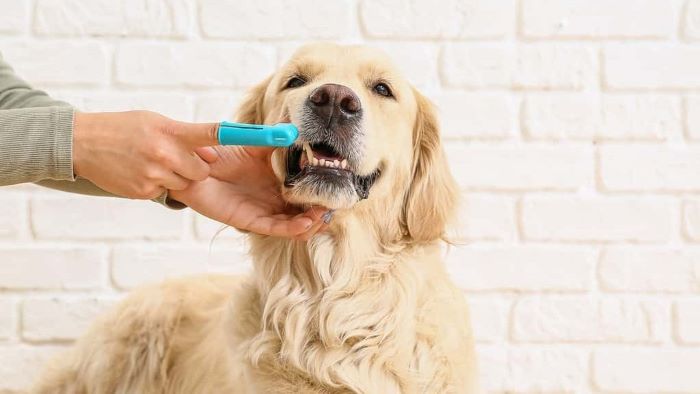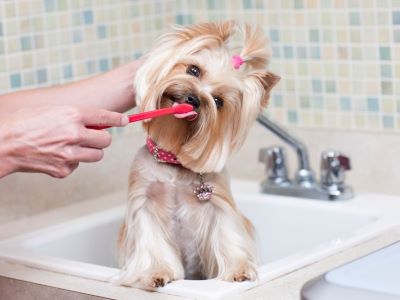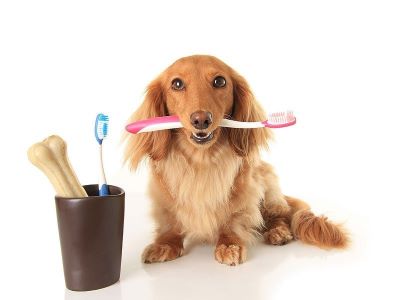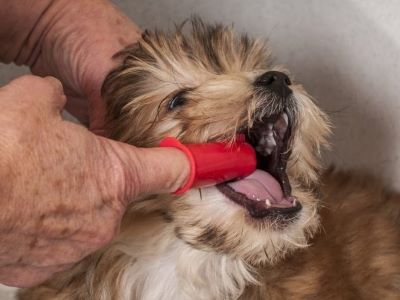How can you ensure your dog’s shining teeth remain as bright as their personality? So, how to brush dog teeth?

The answer lies in the art of brushing your dog’s teeth – an often neglected but essential part of their overall well-being. In this guide, we’ll explore the basics of brushing your dog’s teeth.🐶
So, grab your dog-friendly toothbrush🪥, and we’ll embark on a journey to discover the secrets of maintaining your dog’s oral health, ensuring not only a fresher breath but also a happier and healthier dog.
How to Brush Dog Teeth?
Brushing your dog’s teeth is an important part of caring for them. It helps to prevent dental diseases that can have a serious impact on a dog’s health and longevity.
Regularly brushing your dog’s teeth🦷 can help keep their teeth and gums healthy and prevent dental issues. According to the experts at WebMD, "It can also help prevent bacteria🦠 from entering their bloodstream through gaps created by receding gums."
Spend as much time as you can, for as long as your dog will allow, as it is more important than professional cleaning in terms of maintaining oral health. Let’s see detailed steps to brush your dog’s teeth:
1. Gather Supplies
Here are some supplies you will need[1]:
| Supplies📝 | Importance |
|---|---|
| Dog-specific Toothbrush | Safely reaches all parts of your dog’s mouth.🪥 |
| Finger Brush | An alternative for dogs resistant to traditional brushes. |
| Dog-specific Toothpaste | Essential to prevent harm from fluoride in human toothpaste, comes in enticing flavours for a positive experience. |
When choosing a toothbrush, consider an ultrasonic toothbrush, which can be a great option for dogs. Look for a brush specially designed for dogs and check reviews to find the best ultrasonic toothbrush uk

2. Prepare Your Dog
Gradual introduction to the toothbrushing process can reduce anxiety and resistance in dogs.
- Allowing your dog to sniff and interact with the toothbrush and toothpaste helps alleviate any nervousness.
- Choosing the right environment and introducing your dog to the brushing process is crucial.
- Choose the right time to brush your dog’s teeth. When they are calm and relaxed, after their exercise, and after playtime is an ideal time because your dog is more likely to cooperate.
Avoid brushing immediately after meals🍽️ to prevent any discomfort due to an already sensitive mouth. Allowing your dog to sniff and interact with the toothbrush and toothpaste helps alleviate any nervousness. Choosing the right environment and introducing your dog to the brushing process is crucial. Be sure to also refer to how to remove plaque from dog teeth for tips on plaque removal.
5. Introduce the Toothbrush
Lift their upper lip. As you approach their teeth with the brush, angle the bristles so they reach the gum line.
Placing them at a 45-degree angle against their teeth will help the bristles massage the gum line and clear away plaque[2].
Employing circular⭕ or back-and-forth motions while brushing. Gradually extending the duration of each session as your dog becomes more comfortable is essential to ensure a positive experience. Be patient!
7. Use Positive Reinforcement
Positive reinforcement during and after brushing sessions can significantly increase your dog’s cooperation and reduce their resistance.

Positive reinforcement training uses a reward🦴 (treats, praise, toys, anything the dog finds rewarding🍭). Because the reward makes them more likely to repeat the behaviour, this is one of your most powerful tools for shaping your dog’s behaviour.
8. Gradually Increase Frequency
Regular toothbrushing sessions, ideally 2-3 times a week⌛, are essential to prevent the formation of plaque and tartar.
Increasing the frequency as your dog becomes used to the routine can help maintain optimal dental health.
By combining these evidence-based insights into your dog’s dental care routine, you can ensure that you are not only keeping their teeth and gums healthy but also making the experience as comfortable and enjoyable as possible for your furry friend.
Maintain Dental Toys and Chews
In addition to regular brushing, dental toys and chews play a crucial role in your dog’s oral health!
- These specially designed toys and treats help keep your dog’s teeth clean and gums healthy between brushing sessions.
- Dental toys, such as rubber chew toys🧸 or dental bones, are often textured or ridged to promote dental hygiene by scrubbing away debris as your dog gnaws on them.
- Some dental chews are formulated to fight bad breath and reduce the risk of dental disease, adding an extra layer of protection to your dog’s oral health.

When choosing dental toys and chews always consider your dog’s size and chewing habits.
Signs of Dental Problems
To maintain your dog’s oral health, vigilance is crucial. Watch for signs of dental problems such as bad breath, difficulty chewing, bleeding gums, or changes in behaviour like irritability.
Regularly inspect their mouth for abnormalities. If you notice any issues, consult your vet promptly. Schedule routine check-ups to catch dental problems early and receive professional cleanings as necessary.🧹🪥
These examinations also enable your vet to provide tailored dental care advice and suggest dental diets or products.
FAQs
❓What Is the Easiest Way to Brush a Dog’s Teeth?
Hold down the bottom lip and brush the bottom teeth. Start with the front teeth, then move to the side and back. On the bottom teeth, brush the sides and back. If your dog is tolerating toothbrushing, you can brush both the outside and inside of the teeth when you are brushing.
❓Can I Use Coconut Oil to Brush the Dog’s Teeth?
If you’re looking for a more natural way to brush your dog’s teeth, consider using coconut oil. Coconut oil is safe for dogs to consume, and can help reduce plaque and tartar build-up on their teeth. To use coconut oil to brush your dog’s teeth, simply rub a small amount of coconut oil onto their teeth and gums.
❓What if I Never Brush My Dog’s Teeth?
Working up to brushing daily is ideal. But if their mouth is healthy, even three days a week can make a difference. Without brushing, plaque can build up, putting your dog at risk for bad breath, gum disease, and tooth decay. It can also cause painful infections.
Summary
And that is how we discovered, “How to brush dog teeth?”, learning how to brush your dog’s teeth🦷 is a vital journey rooted in care and commitment to their well-being.
Though it might seem challenging initially, the steps we’ve covered can gradually turn into a positive routine that not only maintains your dog’s oral health but also strengthens your bond. Patience and consistency are your best friends.
So, embrace this journey with optimism, if you’d like more guidance on how to brush your dog’s teeth or any other aspect of their care, please don’t hesitate to ask. Your dog’s well-being is worth every effort, and we’re here to help you along the way!🐶
If you’re looking for ways to clean your dog’s teeth without brushing, be sure to check out our tips on using dental chews and toys. You can also find more on our guide how to clean dog teeth without brushing?
Reference:
- American Veterinary Dental College. (2023, August 9). Home – Setting the standard for veterinary dentistry. AVDC.org – American Veterinary Dental College.
- Tips for brushing a dog’s teeth. (n.d.)- WebMD.



